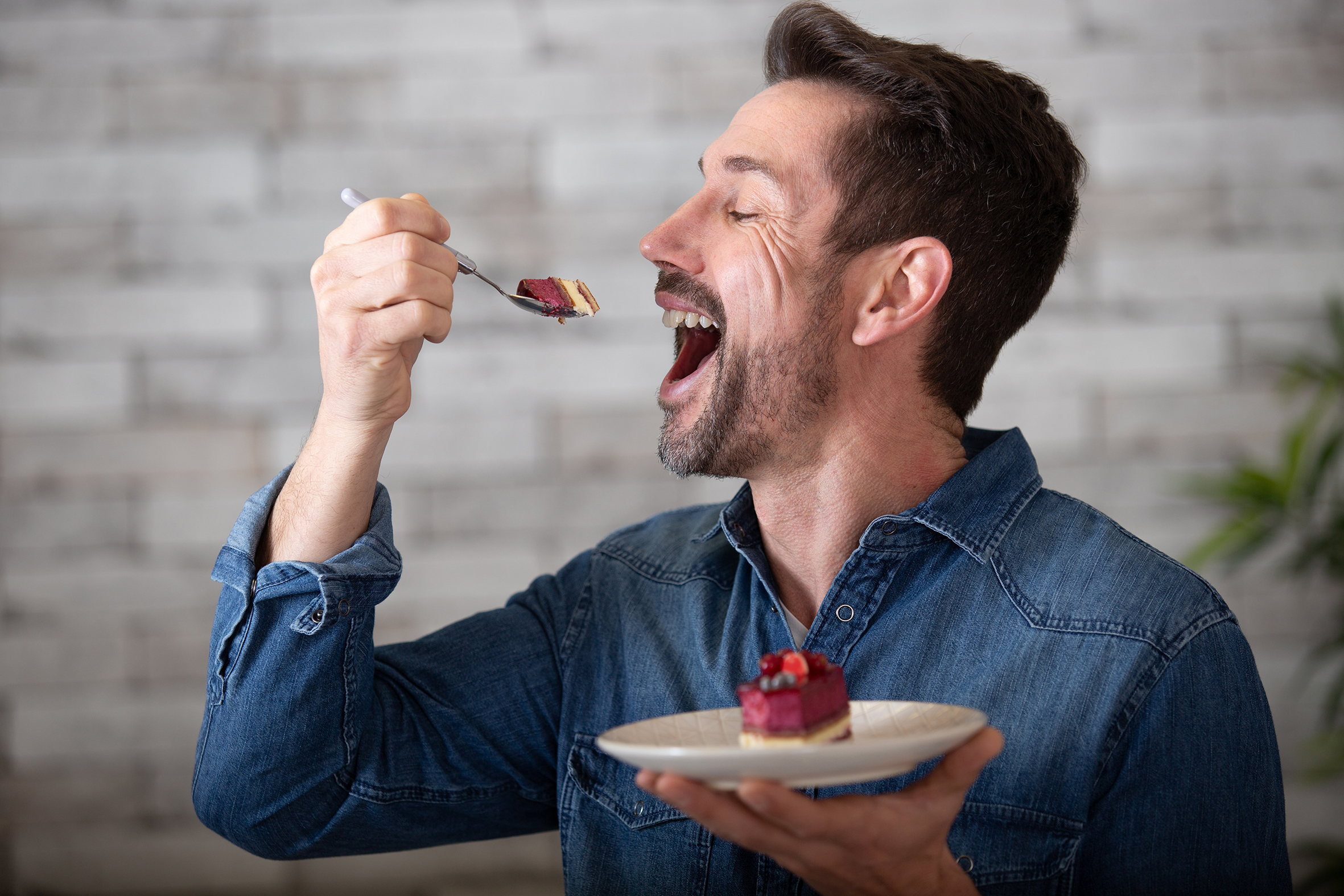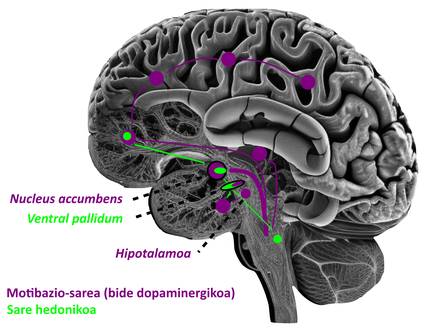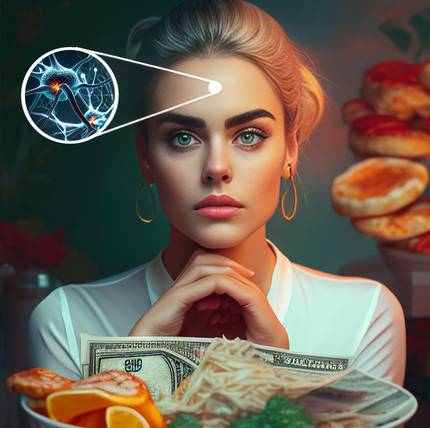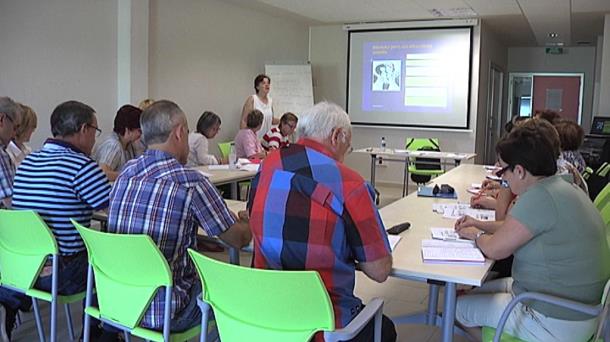Why do I like what I like?
2024/03/01 Huguet Rodríguez, Paloma - Max Planck Research School Iturria: Elhuyar aldizkaria
What a pleasure feeling when eating a good chocolate cake! If I could eat all the cake… Then I go out to the street, going through the bakery and I didn’t look at chocolates or pastries, but they call me screaming. What the hell? However bad I have finally understood the phenomenon, now I know why I love sugar so much: it’s not me… The brain system is limbic!

The limbic system is an evolutionarily well-preserved brain neural network, whose main priority is the survival of the individual and the species. To achieve this, we seek evolutionarily beneficial elements, make us attractive, modulate our posture and, finally, acquire the element a sense of pleasure. Among these elements he considers beneficial include food, drink, socialization or sexual intercourse. The caloric content of sugars makes the limbic system very attractive and when consumed it gives a sense of pleasure. In addition, this system can create an association between sugar and the sensation of pleasure and keep it in memory, not forgetting how pleasant it is to eat chocolate. Thus, the probability of repeating the action of eating chocolate increases [1].
It should be clarified that when we say that we like something in daily life we unify three cognitive processes, all of them dependent on the limbic system: (1) “want”, (2) “like” (unconscious feeling), and (3) establish unconscious partnerships with the element we “like” and keep them in memory [2]. The interaction of the three processes leads us to consume elements such as chocolate.
1. “Want”: brain motivation network
If I open the food storage at home and see chocolate, my first reaction is to feel “I want”. This reaction is unconscious, but we can react consciously. Not only that, if I detect any element related to chocolate, for example, if a relative is making pastry and smells chocolate, my reaction is also “I also want!”. But how does the limbic system know what I want? Besides, before I know it (consciously)?
One of the mechanisms used by the limbic system to allow communication among all its structures is the messenger molecules called neurotransmitters. “wanting” chocolate is probably the result of the integrated interaction of many neurotransmitters. However, we will blame dopamine, which has best characterised the investigation.
Dopamine plays a key role in motivation control. You can learn what's good and bad in our environment to get closer to the good elements and get away from the bad ones. By opening the cupboard of the house and seeing chocolate, you can study a noticeable localized increase of dopamine in the structure nucleus accumbens, which makes me “want” chocolate [3, 4]. Moreover, because this structure is connected to the brain's motor system, it can lead to the feeling of "wanting" to become actions. But how did we realize all this?

In one of the pioneering experiments, rats who didn't have breakfast were given the chance to get high-calorie food by stepping a lever, or normal food if not, without action. Under normal conditions, they were repeatedly pushing the lever to get high-calorie food. However, if dopamine receptors were artificially blocked, they stopped pressing the lever and prioritized the food they could get effortlessly [5]. In addition to these observations, mice that do not have the ability to synthesize dopamine do not have the “desired” sensation [6]. Once these experiments were confirmed with others, it was proposed that dopamine produces a feeling of “wanting” something and initiates actions to achieve it.
In order to be able to respond optimally, there is a great interaction between the structures of the limbic system, which allows the integration of information. An example of this is the ability of the hypothalamus to modulate our sense of “desire”. Because hunger is a process that is regulated in the hypothalamus following circadian rhythms, depending on the time of the day, the hypothalamus can incite nucleus accumbens to awaken the food “desire” or silence it [7].
Going back to my chocolate, my situation is noon, but there is still a lot to eat. The hypothalamus is increasingly telling me that I am hungry. I open the kitchen closet and when I see the chocolate I felt “I want”. I got the chocolate, I opened it and put it in my mouth. Now what?
2. Taste: cerebral hedonic network
Scientifically, it is something “at ease” when the unconscious response of the limbic system to a stimulus is a hedonic pleasure. In order to understand this phenomenon, scientists discovered an objective way to measure the sensation of pleasure in different species: by measuring brain activity and analyzing facial reflexes. For example, by analyzing the affective response of the face and mouth, we can observe that newborns (socially unconditioned beings), monkeys and rodents have the same indicators: the sweet taste is expressed as a placental stimulus that is expressed by relaxing the muscles of the face and laminating the lips, while the bitter taste is an unpleasant stimulus that is expressed by opening the mouth and shaking the head [8].
The limbic system has specific spaces to “like”: hedonic structures. Through them, they give us a sense of pleasure by obtaining evolutionarily beneficial elements. It is difficult to determine the hedonic structure which is the main motor and modulator, but it seems that we have a dominant hedonic structure: ventral pallidum. To reach this conclusion, two types of experiments were key: (1) the injection into the structure of two excited molecules of local neurons greatly increased the sensation of sugar pleasure in rats [9, 10]; and (2) the destruction of neurons in the structure prevented the appearance of stimuli that produced a sensation of pleasure [11].
Listen, but in our daily lives there is nothing else we are pleased about, apart from food, drink, socialization and sexual relations?
3. Associations and memory building
The process described follows elements that we classify as intrinsic, such as chocolate (food). But there is something else that we are pleased about. There are, in principle, elements that do not generate hedonic pleasure, but because of their association with intrinsic elements, they generate hedonic pleasure; these types of elements are called extrinsic elements.

For example, money does not awaken feelings of “taste” or “desire” in newborns, but in adults. Because adults have associated the ability to get money, and that association is stored in our memory. With money, among other things, we can buy food (intrinsic element), so our limbic system will trust in the association money/food and “like” and “want” money. However, the motivational network of the limbic system checks at all times whether this association money/food is correct and if the money stops predicting food, the positive response of the limbic system will be reduced to disappear [12].
Associations are constructed through synaptic plasticity in the language of neurons and, as has been seen, can modify the opinion of the limbic system. Synaptic plasticity alters communication between neurons, silencing or increasing their voice, or creating new communication channels.
Drugs, limbic system weakness
As we have said, the activity of the limbic system is completely unconscious, without our control. Associations can change, but we cannot control their training either. All we can control is how we respond to sensations. We therefore have no choice but to rely on the limbic system. Is it reliable?
Addictive drugs (cocaine, opioids, alcohol, etc.) are chemically very different pharmacological substances with different molecular ites, but all increase dopamine concentration [13]. Thus, although they are evolutionarily not beneficial, they activate the motivational network of the limbic system and, therefore, give us the feeling of “wanting”. As a particularity, addictive drugs can activate the network unlike natural stimuli, causing a huge sense of “desire”. To explain why drugs cause addiction, it is believed that the key is the feeling of “wanting” the drugs cause, because their intensity makes silencing more difficult. They also produce a sensation of pleasure (taste), but in this case as natural stimuli.

In addition, repetitive drug use can increase the intensity of that feeling of “desire” until the body loses the ability to control how to react to that feeling. This loss of control is a disease we call drug addiction. Drugs also exploit plasticity mechanisms within the limbic system to maintain drug-associated memories with high rigidity and long duration. Consequently, in individuals who have overcome addiction, despite abstinence for many years, the perception of an element associated with drugs (a smell, a context) is sufficient to resurrect that feeling of “desire” [14].
So why do we like what we like?
Short response: greater probability of survival. This is the goal of the limbic system, and it works constantly to do so. By saying that we like something in everyday language, we say that we “want” and “like” something unconsciously, and both feelings depend on many associations and memories. In general, the limbic system is the one that sets what we like, but because our brain has plasticity, the opinion of this system can vary through associations or modulating other brain systems.
Bibliography
[1] Faure, A., Reynolds, S. M. Richard, J. M. Berridge, K. C. Mesolimbic dopamine in desire and dread: Motivation to be generated by localized glutamate disruptions in nucleus accumbens. J. Neurosci. (2008). justiprice:10.1523/JNEUROSCI.4961-07.2008
[2] Morales, I. Berridge, K. C. ‘Liking’ and ‘wanting’ in eating and food reward: Brain mechanisms and clinical implications. Physiology and Behavior (2020). justiprice:10.1016/j.physbeh.2020.113152
[3] Bromberg-Martin, E. S. Matsumoto, M. & Hikosaka, O. Dopamine in Motivational Control: Rewarding, Aversive, and Alerting. Neuron (2010). doi:10.1016/j.neuron.2010.11.022
[4] Brauer, L. H. & De Wit, H. High dose pimozide does not block amphetamine-induced euphoria in normal volunteers. Pharmacol. Biochem. Low. (1997). justiprice:10.1016/S00913057(96)00240-7
[5] Salamone, J. D. et al. Haloperdol and nucleus accumbens dopamine depletion suppress lever pressing for food but increase free food consumption in a novel food choice procedure. Psychopharmacology (Berl). (1991). adjustment:10.1007/BF02245659
[6] Cannon, C. M. & Palmiter, R. D. Reward without Dopamine. J. Neurosci. (2003). price: 10.1523/jneurosci.23-34-10827.2003
[7] Castro, D. C. Cole, S. L. Berridge, K. C. Lateral hypothalamus, nucleus accumbens, and ventral pallidum roles in eating and hunger: Interactions between homeostatic and reward circuitry. Frontiers in Systems Neuroscience (2015). price:10.3389/fnsys.2015.00090
[8] Berridge, K. C. & Robinson, T. R. Parsing reward. Trends in Neurosciences (2003). justiprice:10.1016/S0166-2236(03)00233-9
[9] Ho, C. Eta. Berridge, K. C. An orexin hotspot in ventral pallidum amplifies hedonic ‘liking’ for sweetness. Neuropsychopharmacology (2013). price: 10.1038/npp.2013.62
[10] Smith, K. S. Berridge, K. C. The ventral pallidum and hedonic reward: Neurochemical maps of sucrose ‘liking’ and food intake. J. Neurosci. (2005). justiprice:10.1523/JNEUROSCI.1902-05.2005
[11] Cromwell, H. C. Berridge, K. C. Where does damage lead to enhanced food aversion: the ventral pallidum/sustantia innominata or lateral hypothalamus? Brain Res. (1993). adjustment:10.1016/0006-8993(93)90053-P
[12] Schultz, W. Dopamine reward prediction error coding. Dialogues Clin. Neurosci. (2016). price:10.31887/dcns.2016.18.1/wschultz
[13] Olds, J. & Milner, P. Positive reinforcement produced by electrical stimulation of septal area and other regions of rat brain. J. Comp. Physiol. Psychol. (1954). price: 10.1037/h0058775
[14] Dong, Y. & Nestler, E. J. The neural rejuvenation hypothesis of cocaine addiction. Trends in Pharmacological Sciences (2014). doi:10.1016/j.tips.2014.05.005.

Gai honi buruzko eduki gehiago
Elhuyarrek garatutako teknologia






